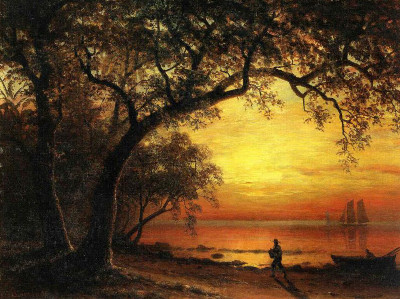Island of New Providence is a romantic landscape painting by Albert Bierstadt which is dated to 1891. The item resides within a private collection and not a lot of information is available on it.
The artist illuminates the canvas with a dominate glow of light which is delivered from the very centre of the composition. A single figure walks across the scene, providing perspective, whilst another starts to get out of his fishing boat on the right hand side. Perhaps the two have been out all day, working hard and are now off home to rest for the evening. All of this scene is carefully crafted and it is unlikely that the actual environment was quite as perfectly angled for this painting. See, for example, of how the tree nearest us leans over to the right hand side in a curved manner which beautifully framed the content behind it. Even a small branch points downwards in the direction of the boat, suggesting that Bierstadt used a certain level of artistic license to 'perfect nature' as he used to describe it.
This process of adapting reality for his art left behind aesthetically pleasing paintings that the public loved, but some critics would be unhappy with this approach. Behind the key tree are a number of others, which slowly lead off to the left hand side, providing a screen across that part of the painting. The foliage also continues on across the top part of the canvas. This all has the impact of creating a window through which we can view the main content, which is the sea lapping along the beach, plus a larger ship away in the background. Bierstadt then adds some long shadows in the foreground which increase this feeling of the day's light slowly creeping away. The artist would feature beach scenes many times within his career and captured them from a good variety of locations, with both sandy and more rocky environments both covered.
Island of New Providence would come in the last decade of this artist's life, and what we find here is the style in which he finished his career. He would romanticise to the fullest degree, adapting reality to create his perfect worlds. Seascapes would appear many times within this last period, and lighting would be used in an even more ambitious manner than previously had been the case. Many of the pieces produced then were not amongst his most famous paintings and were also snapped up by collectors, meaning some have only been documented in a very brief manner. Many of his best known items were from earlier on in his career, but it is certainly worth studying the full breadth of work that he completed across his lifetime, with some variety to be found.




